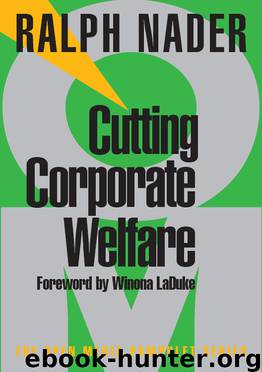Cutting Corporate Welfare by Ralph Nader

Author:Ralph Nader [Nader, Ralph]
Language: eng
Format: epub
ISBN: 978-1-60980-201-1
Publisher: Seven Stories Press
Published: 2011-01-03T16:00:00+00:00
SPECIAL BAILOUT PROBLEMS
The S&L looters are back. A federal judge in California has ruled that Congress broke the government’s contract with Glendale Federal Bank when capital based on goodwill was outlawed in the 1989 savings and loan reform legislation.40 The court awarded the corporation $908.9 million. There are some 125 suits pending with claims similar to those of Glendale. If the Glendale case is a precedent, the government could lose another $30 billion on top of the nearly $500 billion in principal and interest that has already been obligated in the S&L bailout, with some of the new corporate welfare benefits conferred, as the New York Times has pointed out, on some of the more notorious figures in the savings and loan debacle, including some who are serving prison terms.41 The 1989 reform legislation properly insisted that failed institutions be closed and that remaining S&Ls have adequate capital—actual capital, not the fake capital represented by something as vague as goodwill.
The Glendale case presents two problems. One is how vigorously the Clinton Administration Justice Department is contesting the Glendale line of cases. The second issue is how the Glendale claims will be paid, if in fact courts hold that they must be. The New York Times reports that a provision was inserted into last fall’s omnibus appropriations bill—without hearings or open debate, in yet another example of how corporate welfare giveaways are bound up with anti-democratic procedures—that was designed to allay fears of lobbyists that the Treasury Department might refuse to pay or that the industry might end up being saddled with the costs through a special assessment.42 This provision must be repealed, and it should be promptly replaced with legislation that assesses the special fee the industry opposes. The 1989 reform effort, including the implementation of strict capital rules and the elimination of worthless imitation capital like goodwill restored confidence in the savings and loan industry. This restoration of confidence has been a sizable government benefit, courtesy of the taxpayers, to the entire financial industry and its shareholders, and particularly to the thrift sector. It would be wrong for the taxpayers, who have borne the brunt of the savings and loan bailout, to now be required to pay the judgments of these goodwill suits.
And now another set of corporate rogues—the tobacco pushers—may be set to avail themselves of a bailout stratagem. The normal course for a company that cannot pay its bills is not to turn to the government, but to enter into Chapter 11, temporary bankruptcy. Since the 1979 reforms to the bankruptcy laws, large corporations have increasingly used bankruptcy as a refuge from large civil liability claims. A.H. Robins, Johns Manville, Union Carbide, and Dow Corning are among the companies which have followed this route,43 and Big Tobacco is now waving the threat of bankruptcy to strengthen its bargaining position in lawsuits and in the legislative process. These companies have manipulated the bankruptcy code to force victims of dangerous products or dangerous production processes to absorb some substantial portion of the costs of their injuries and to separate future income streams from liability.
Download
This site does not store any files on its server. We only index and link to content provided by other sites. Please contact the content providers to delete copyright contents if any and email us, we'll remove relevant links or contents immediately.
The Secret History by Donna Tartt(18852)
The Social Justice Warrior Handbook by Lisa De Pasquale(12143)
Thirteen Reasons Why by Jay Asher(8800)
This Is How You Lose Her by Junot Diaz(6797)
Weapons of Math Destruction by Cathy O'Neil(6148)
Zero to One by Peter Thiel(5691)
Beartown by Fredrik Backman(5602)
The Myth of the Strong Leader by Archie Brown(5428)
The Fire Next Time by James Baldwin(5250)
How Democracies Die by Steven Levitsky & Daniel Ziblatt(5130)
Promise Me, Dad by Joe Biden(5088)
Stone's Rules by Roger Stone(5027)
A Higher Loyalty: Truth, Lies, and Leadership by James Comey(4848)
100 Deadly Skills by Clint Emerson(4843)
Rise and Kill First by Ronen Bergman(4705)
Secrecy World by Jake Bernstein(4652)
The David Icke Guide to the Global Conspiracy (and how to end it) by David Icke(4629)
The Farm by Tom Rob Smith(4439)
The Doomsday Machine by Daniel Ellsberg(4420)
